The right for the French East India Company to possess slaves was, in fact, confirmed through a decree issued by the higher Council of Bourbon island on 27th September 1724. When the French Crown once more de facto took over the administration of the Mascareignes islands in 1767, the local government unflinchingly accepted inheritance of this “ghastly stock”, not without making a profit from it over the years. Estimated by the authorising officer Honoré de Crémont to be 369 in 1768, many years later, in 1836, his successor Léon Dalmas listed 1,093 “blacks” present in the “colonial workshop”.
The increase in numbers of this population, though fluctuating during this period, could initially be considered as being due to the work-force constantly needed by the island’s authorities for the running of its public structures at the lowest possible cost. However, on looking more closely, we note that these ‘captives’ did not all have the statute of slaves, far from it. Under the July Monarchy, most of them had the status of indentured labourers. Similarly, these men and women were not not all employed to carry out manual tasks for the construction and upkeep of the colony’s large infrastructures. Many of them were employed in various public institutions and Bourbon island’s “State-owned Blacks” were employed under a range of conditions and “prospects”.
Until 1848, the “State-owned Blacks” – recognised as slaves – came under the same legal status as those belonging to private owners. In this respect, the introduction to the local decree issued on 7th September 1767 stipulated that they all came under the edict of December 1723, commonly referred to as the “Black Code”. First of all considered as “goods”, these men and women belonging to the public authorities had been acquired partly from settlers on the island. On 28th August 1780, on behalf of the King, the authorising officer Jean Charles Pottier, marquis of Courcy, paid out 1,225 pounds to Mr Châtillon, an inhabitant residing in a neighbourhood in Saint-Denis, for the purchase of “a certain Ignace, of Malabar caste, aged 18 and exercising the function of blacksmith”. However, at least up to and during the First Empire, it was not exceptional for the authorities of Bourbon island to to purchase captives directly from ship-owners involved in the slave trade. As an example, on 8th December 1772, for the sum of 63,220 pounds, they purchased no less than “forty Mozambican Blacks, strong male slaves, seven Negro women and fourteen “caprons” from a certain Mr Baillif. Owner of a vessel sailing from East Africa that had recently anchored in the bay of Saint-Denis with a cargo “consisting of close to two hundred Negroes”, as part of the contract, the latter even authorised the colony’s head surgeon to go on board to personally select the captives. In addition, the ‘colonial workshop’ was also increased thanks to babies born to “the King’s Negresses”, both in or out of wedlock. In 1815, Rosalie, a Creole nurse aged 25, was already mother to 3 children: Marguerite aged 6, Marie-Olive aged 4 and Louis aged 2. Under article 8 of the edict issued on 8th December 1723, all three of them at their birth were legally given the same status as their mother and became property of the colony.
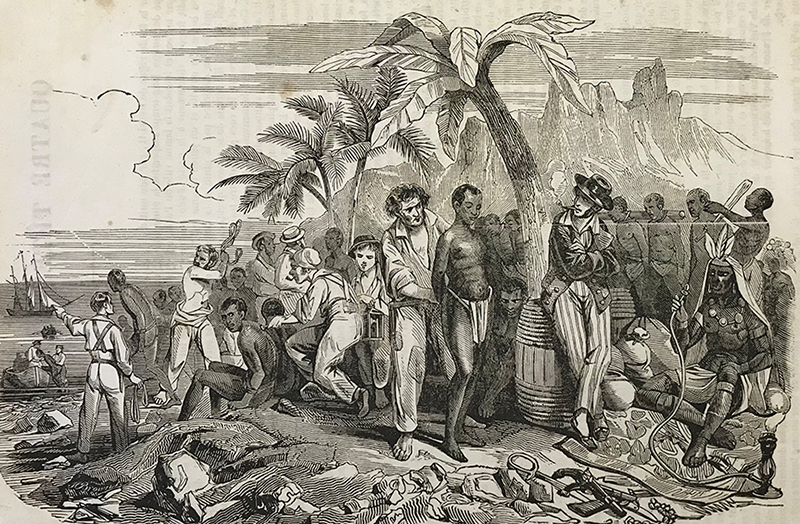
Legally disposing of the right to ‘use and enjoy’ their “property”, the authorities of Bourbon island were able to “abuse” them as they wished, at least in accordance with the rights of slave owners applicable in the colony. Under the Restoration, Pauline and Pélagie, both seamstresses in their 20s from Madagascar, were rented out for several years to the governor Etienne du Val d’Ailly for his personal service for 30 francs a month. The public authorities could, of course, dispose of “live possessions”. On 14th December 1783, Joseph and his wife Perrine were sold in the name of the King by the ordering officer Jean Charles Pottier marquis of Courcy to Mr Larochelle, residing in the district of Sainte-Suzanne, for the sum of 1,350 pounds. While the authorities of Bourbon island respected the vows pronounced by the two slaves, which forbade their being separated in the event of a sale or donation, they also almost certainly found that this was a good way to get rid of Perrine, listed in the margin of the sales register as suffering from epilepsy.
Just like other other slaves in the colony, those employed in the “colonial workshop” could also claim freedom. From the archives, however, we learn that the authorities of Bourbon Island applied this procedure even less frequently than did private owners. Included in the “King’s stock of Blacks’ in 1767, Charlot, aged 35 from Madagascar, commander of engineering works, several times congratulated for his “loyalty and hard work” and officially granted his liberty on 7th November 1779, was considered to be along the privileged few. However, Charlot apparently came up against a number of serious difficulties when it came to becoming autonomous. In all evidence, psychologically affected by being uprooted from his native land and possessing no savings which might enable him to acquire land or some form of professional training, he was unable to find any stable activity in the colony. According to the general census of 1st January 1782, destitute and homeless, he was still housed and fed “at the King’s expense’”.
The status of slave remained applicable for a large number of “State-owned Blacks” on Bourbon island, including under the Restoration and the July Monarchy, even though the royal ordinance signed on 8th January 1817, which followed the recommendations of the Treaty of Paris dated 20th November 1815, followed by the laws passed on 15th April 1818 and 25th April 1827, prohibited the “slave trade” being carried out in the French colonies. Under the pressure of the settlers, who, as usual, put forward the argument of the shortage of labour, the authorities of Bourbon island turned a blind eye to the continued trading of “ebony wood” on the island. The most precise historical studies on the topic give an estimate of between 45,000 and 50,000 captives deported and brought into the Indian Ocean French colony between 1817 and 1840. The “traded Blacks”, however, were a real boon for the island’s authorities. Indeed, the royal ordinance dated 8th January 1816 succinctly provided that those seized on board “vessels” and destined to be taken to a French colony would be employed to carry out “public utility works”. Since the authorities in mainland France had never legislated or drawn up regulations concerning their status under the Restoration, they were, on Bourbon island, integrated into the “colonial workshops” under the status of … slaves. The local decree issued by the governor Achille de Cheffontaines on 3rd March 1827 concerning the organisation of the services of these “Colonial Blacks” does not differentiate between captives acquired by the colony before 8th January 1817 and “traded Blacks” later confiscated from slave ships.
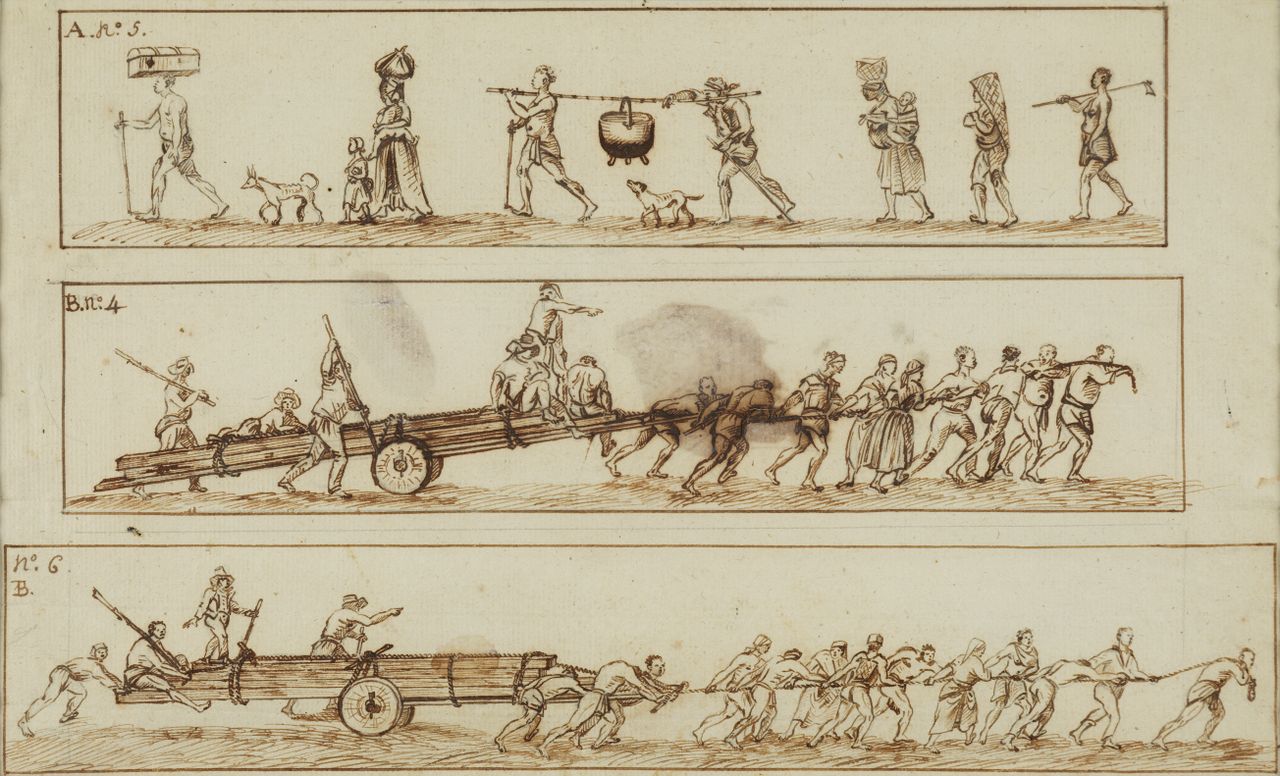
Collection of Reunion departmental archives.
A study of these “State-owned Blacks” necessitates an analysis of their status as “indentured labourers”. A reading of the regulations on Bourbon island shows that they absolutely did not benefit from the same rights as free persons in the colony, including free coloured persons or even Indian and Chinese labourers, also referred to as indentured labourers, who migrated to Bourbon island under the July Monarchy. In this respect, their civil status did not come under the public authorities of the town councils, but under the authority of the public prosecutor appointed by the Royal court. Their marriage was submitted to the authorisation of the governor it was strictly prohibited for them to exercise tutelage over another person. In the same way, they had no right to own property and could not acquire possessions through purchase, donation or inheritance. Blatant proof of their status remaining close to that of slaves: any offences committed by these contractual workers did not come under the French criminal code of 29th December 1827, applied to free persons, but under the criminal code applied to slaves. Article 15 of the local decree dated 4th August 1831 was admirably concise: a “traded Black” only achieved the status of freed person “listed in the register of the civil status documents of the free population” and the benefits of “full enjoyment of civic rights” when he or she was released from his or her commitment by the governor.
Aware of the precarious character of their status and the fragile nature of their condition, the authorities on Bourbon Island, through a decree issued on 11th August 1838, forced all the “traded Blacks” to sign a new seven-year contract coming under the same legal status. The prescriptive document, several clauses of which did not comply with the law of 4th March 1831, was repealed on 25th June 1841 by Victor-Guy Duperré, minister of the Navy, not without provoking protests from local elected representatives. On 28th October 1841, this same minister of the Navy also insisted on the authorities of Bourbon island collectively registering all the “traded blacks who had terminated their contract” in the civil status registers of the free population of the town council of Saint-Denis. It was also following an injunction of the Ministry that on 31st May 1842 the authorities of Bourbon island issued a new decree concerning the “re-employment of free indentured labourers”, taking into account their status as free persons. However, the pressures exercised over the deported persons by the public authorities led to most of them signing a new four-year contract. Fully informed on the issue, the magistrate of Bourbon island Delabarre de Nanteuil indicated that on the date concerned out of the 520 “freed contractual labourers”, only 34 apparently refused to sign a new contract with the colony!
The contracts these “victims” of the slave trade were forced to sign came under the “dominant culture” of forced labour in colonial slave-owning societies. During the first half of the 19th century, indentured labour was similarly forced onto close to 12,000 captives liberated by the British Navy in the Atlantic Ocean, enabling the United Kingdom to develop “Black military regiments” essential to keeping public order in the Caribbean colonies belonging to Britain at a reduced cost. According to the Nigerian historian Johnson Asiegbu, who has carried out work on the topic that to this day remains unequalled, this was a cunning procedure that enabled the local authorities of European colonies to recruit as indentured labourers new African and Asian migrants once slavery had been abolished.
Slaves or indentured labourers, with few exceptions, “State-owned Blacks”, were subjected on a daily basis to compulsory labour, with the exception of the times and days of rest defined by the local regulations. “Pure blacks or Creoles’, essentially farmers in their country of origin or “Black labourers” working on the estates of Bourbon island, however, they no longer carried out agricultural work when under the authority of the public bodies. At least half of them were employed in one of the mobile brigades attached to the civil engineering department of the colony, entitled ‘Ponts and chaussées’ under the First Empire. Determined to develop road links and construct public buildings, over the entire period concerned, the authorities of Bourbon island, however, suffered from a shortage of “free work-force” in the colony. Under the direction of engineers trained in mainland France, the labourers depending on the “colonial workshop” were thus made use of, exercising the most exhausting tasks linked to public works, such as clearing tracks, digging ditches and laying down tarmac.
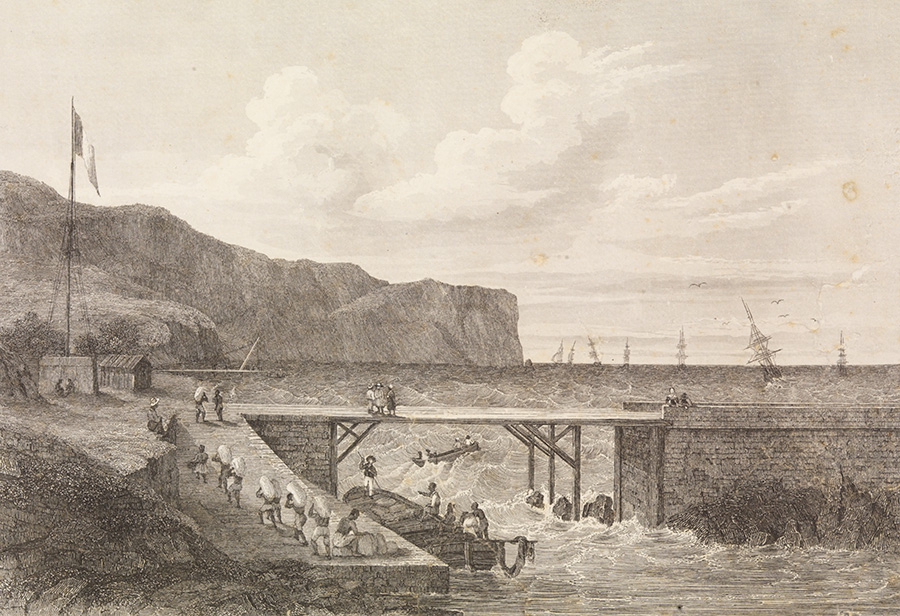
The other half of these ‘colonial Blacks’ were distributed out to work in all the public institutions of the colony: hospitals, general warehouses, the Royal gardens, the Postal service etc. Some of them received specific training, such as that of blacksmith, wheelwright or mason, giving them a more autonomous and rewarding daily activity. Hypolite, a Creole born into the “colonial workshop” in 1772 and trained very early on as a carpenter, for several decades was able to exercise “comfortable employment” at the State mills, to quote the terms used by the deputy Prefect Marchant under the Second Empire. However these “trained Blacks” were few in number. Placed under the authority of public agents of “free status”, others occupied secondary posts such as that of cook, health carer, gardener or caretaker, carrying out tasks that were repetitive and often exhausting. Indeed, the daily work of the labourers rowing in the harbour of Saint-Denis was undoubtedly just as exhausting physically and morally as that carried out by the labourers subjected to constructing the Kings highway.
With the exception of the commanders and a few who were paid “wages”, representing less than 10% of the total number, the “Blacks” of the “colonial workshop” were not paid for the work carried out! While the situation may appear coherent regarding the slaves, at least in the eyes of those supporting the “specific institution”, the policies applied to the indentured labourers represented a serious infringement of the law. Under the July Monarchy, the French government addressed several notices to the authorities of Bourbon island, before issuing the decree of 31st May 1842. However, the amounts to be paid remained derisory. In the application of the decrees dated 3rd March 1827 and 4th August 1831, a commander awarded a medal for his services was paid a salary of 8 francs per month, a standard commander 4 francs and a wage-earning labourer 2 francs! These salaries appear totally derisory when compared with those paid to persons of free condition directing their work: the head of a brigade linked to the “colonial workshop” was paid 50 francs a month and a civil engineer 750 francs.
Outside working hours, most of them were housed in specific accommodation, referred to as the “camp of the King’s Blacks”, set up during the Royal period in the colony’s chief town, to the west of the rivière Saint-Denis. Measuring close to 5 hectares, its structure was not dissimilar to that of the large estates on the island. In addition to the workers’ huts, described as being cramped and unsanitary, housing the slaves and indentured workers living alone or with their families, it consisted of a storeroom for food, an infirmary and even police premises. Lepers, on the other hand, were housed in separate accommodation, which was used until 1852, when the leprosarium of la Ravine à Jacques was constructed for the colony’s lepers.
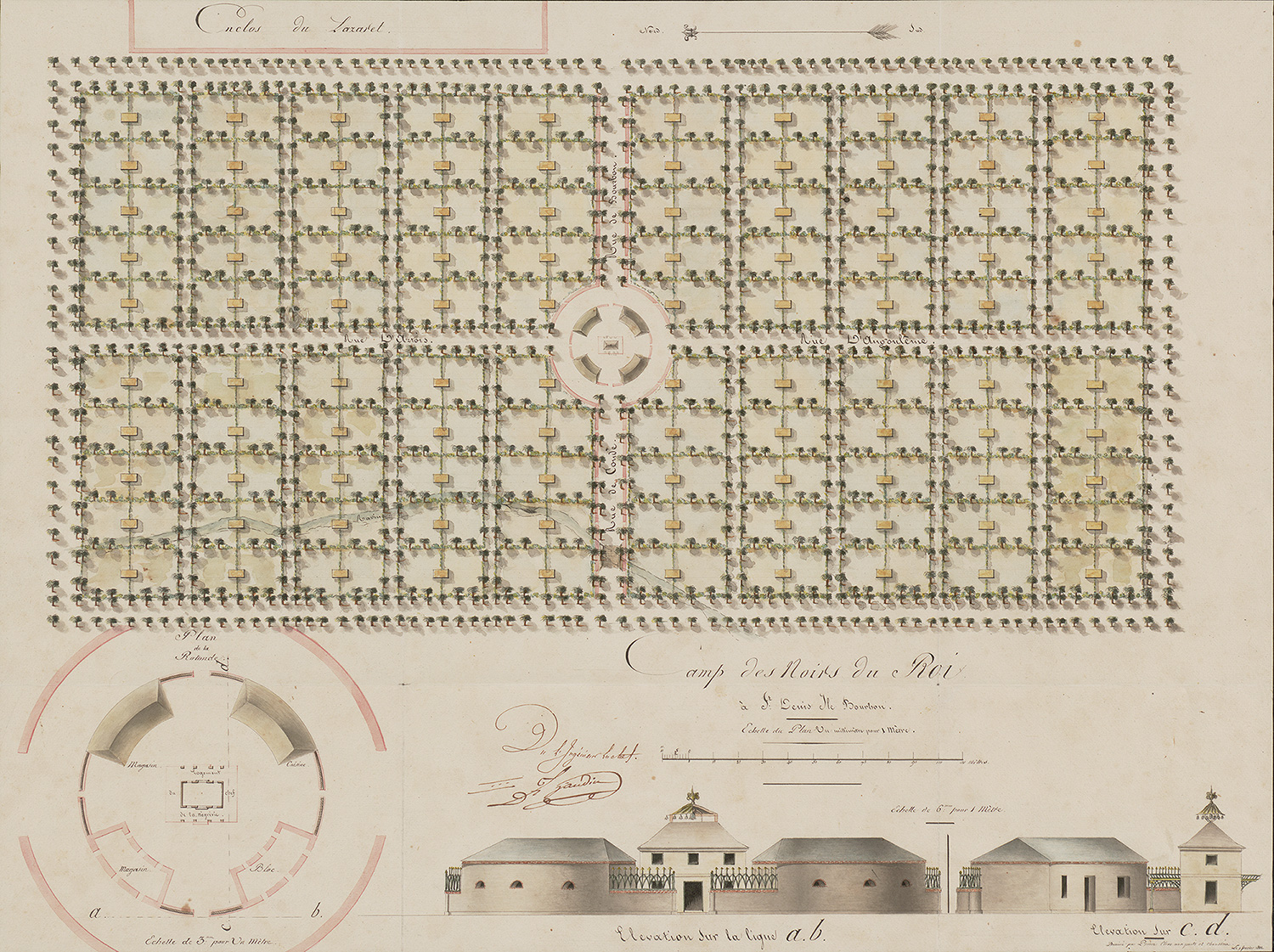
The “colonial Blacks”, whatever their status, were, in fact, fed, clothed and, when necessary, received health treatment in application of specific regulations which, however, closely resembled those applied to “Blacks” belonging to private owners. Their daily food ration distributed by the authorities was limited to 1 kilogram of corn or 800 grams of rice, with 120 grams of pulses. On Sundays and holidays, they would also be given 100 grams of salted cod or meat. In total, this daily ration only just represented 1,500 calories for persons who carried out, it should be emphasised, tasks necessitating at least 3,500 calories. Twice a year, the men were provided with a pair of trousers and a shirt, and the women with a skirt and a tunic, all made out of poor quality ginga textile. In order to differentiate them from persons of free condition, particularly coloured persons, the colony’s ‘State-owned Blacks’, in the same way as the slaves on Bourbon island, were forbidden from wearing shoes.
Consequently, it is not surprising that their health was extremely precarious and their life expectancy greatly reduced. A few figures from the different reports produced by the authorities of Bourbon island sufficiently demonstrate these shortcomings. Between 1st January 1820 and 1st January 1821, the population of the colonial workshop increased from 428 to 630 persons. However, this increase was first of all the consequence of the purchase of 23 slaves from private owners and more particularly 247 “traded Blacks” confiscated from slave ships. In actual fact, during that period the “king’s stock of Blacks” recorded just 4 births for 72 deaths! The death rate, close to 150% among the “State-owned blacks”, was far higher than that among the other slaves on the colony. In addition, the death rate was just as high among the indentured labourers. Estimated at 876 in number on 1st January 1836, on 28th October 1841 only 520 remained, though none of them could have broken their contract during those five years. Consequently, on 1st January 1848, a few months before the application of the liberating decree, the “colonial workshop” counted just 91 slaves and 59 indentured labourers.
Despite these appalling living conditions, in addition to a particularly severe authoritarian organisation, the slaves and indentured labourers in the “colonial workshop” were not, however, resigned to a condition of “social oblivion”. Thanks to their resourcefulness, they applied all forms of individual and collective tactics aimed at survival and, even more widely, at preserving their basic rights. As well as the secondary economic activities they developed in addition to their official employment, they maintained important links with family and friends living outside the “camp of the King’s blacks”. They also maintained vernacular or mixed forms of cultural expression, such as the Tshéga, enabling them to maintain their profound humanity.
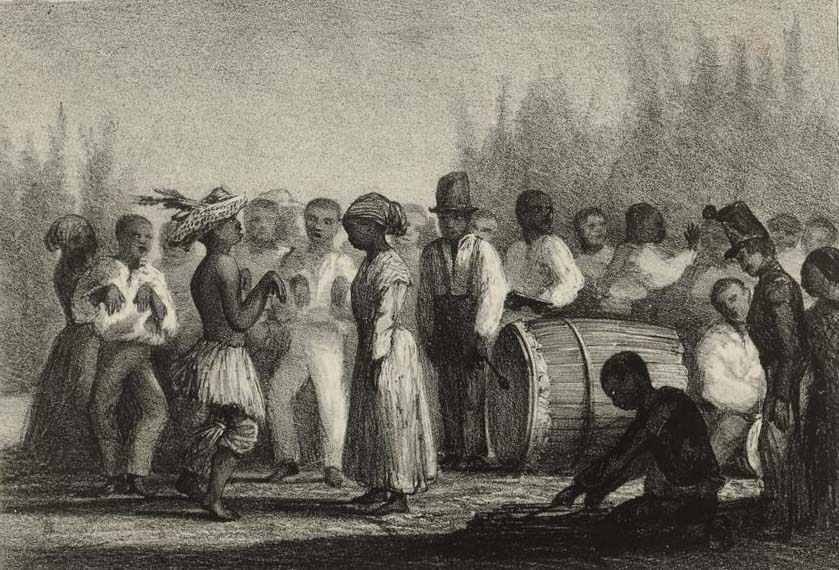
For the more determined amongst them, maroonage (becoming fugitives) became the most radical solution aimed at escaping from this deadly situation. On 1st January 1782, 10 slaves from the “colonial workshop” out of 930 were defined as having become fugitives. On 1st January 1821, the number was 7 out of 630. Thus, on average 1% of the ‘State-owned Blacks’ had become permanent fugitives. This percentage was, it is true, lower than that concerning the total servile population of Bourbon island (around 5% during the whole period), but the handwritten documents consulted on the subject indicate that the “State-owned Blacks” became long-term, very long-term or even permanent maroons. Azor “an African aged 29”, sold to the local government on 30th December 1774 by Mr Beaumont for reasons of indiscipline, then integrated into the civil engineering brigade of Saint-Denis, no longer accepted the authority of his new “master”. He became a “maroon” on 2nd June 1775 and remained free at least until the end of 1782. Similarly, Janvier, also a “22-year-old Black” was seized on 21st September 1819 on the slave ship La Joséphine and immediately sent to work in the civil engineering brigade. Janvier became a maroon as early as 22nd May 1820 and on 1st January 1824 still had not been recaptured. Inexperienced in their home country, Makoua on the Bay of Memba or Nyanja in the high plateaus, hunters or craftsmen, animist or Muslim, both of them immediately decided to break free, then ended up wandering alone at the edges of estates and towns or found “brothers and sisters” in one of the hidden maroon settlements in the mountain cirques in the island’s interior. For Azor and Janvier, it marked the start of a new life.